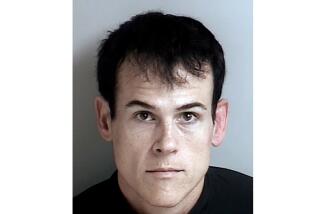‘Power Rapist’ Terrorizing San Clemente : Crime: Sexual assault experts say the man who has committed five rapes since last October is not motivated by violence, but instead by an effort to compensate for feelings of inadequacy by exerting force.
SAN CLEMENTE — A man who police believe has committed five rapes and who has unnerved this quiet beach community might be motivated by a need to exert power and to find a “perfect victim” who will resolve his feelings of inadequacy, say local and national experts in sexual assault.
While police have revealed little about the rapist’s habits, experts interviewed last week drew a rough psychological profile of the man based on what information has been released and common traits found in serial rapists.
Last Tuesday night the man struck for the fifth time since October, raping a woman in her Avenida Monterey home. He apparently has stalked his victims and attacked them when he was certain they were alone. Victims have been blindfolded, bound and gagged.
Noting that the rapist apparently has not inflicted further physical injury on his victims, Florida psychiatrist A. Nicholas Groth, a prominent researcher, said the man appears to be a “power rapist as opposed to a sadistic rapist.”
“A power rapist only uses the amount of force that’s necessary to accomplish the act and does not engage in gratuitous violence,” said Deputy Dist. Atty. Jan Sturla, supervisor of the sexual assault and child abuse unit of the Orange County district attorney’s office.
“His pattern suggests that he isn’t motivated by an enjoyment of the suffering of others,” said psychiatrist Fred Berlin, director of the Johns Hopkins Sexual Disorders Clinic in Baltimore. “For this kind of rapist, the stimulus for sexual excitement is coercion--he is turned on by controlling other people.”
Such rapists attempt to compensate for feelings of inadequacy by exerting force on innocent bystanders, researchers said.
“Perhaps he has had unsuccessful relationships with women or perhaps he cannot hold down a job,” said Groth, author of the book, “Men Who Rape.” “In some way, his masculinity has been threatened.”
When a rapist uses a blindfold on the victim, as has the San Clemente assailant, “it could be a good sign that he doesn’t want to kill his witness,” noted Park Dietz, a Newport Beach forensic psychiatrist who frequently works with law enforcement agencies on sexual offense cases.
A less violent rapist might rationalize his assaults as innocuous. “He doesn’t see the psychological trauma he is causing the woman, so he deceives himself into thinking that he is not harming her,” Berlin said.
Often, serial rapists start with the most vulnerable women and gradually gain courage in their pursuit of victims. For instance, said feminist writer Susan Brownmiller: “The Boston Strangler first attacked elderly women, then moved on to younger women as his confidence grew.”
Similarly, the San Clemente rapist apparently began by assaulting a mentally retarded woman and then a 13-year-old girl.
“That may indicate that he doesn’t have a long history of sexual crimes; he may be inexperienced at this,” Groth said. “As he feels more and more experienced, he approaches women closer to his own age.”
The rapist has waged his terror within a 15-square-mile area, rather than branching out into cities where police are not keeping such a vigilant lookout for him. “Criminals continue a pattern that has proved successful for them,” said Santa Ana Detective Frank Stastny. “Plus, part of the thrill of rape to a serial rapist is the danger of getting caught.”
In many cases, a serial rapist originally commits the crime with hopes that it will resolve his inner conflicts. “The rape may temporarily discharge some of the anxieties building up in him, but the effect wears off,” Groth said.
“One reason this becomes repeated behavior is that the experience never lives up to his fantasy,” Groth added. “He thinks: ‘It must have been the wrong victim, the next victim will be the answer to my problems.’ The pattern becomes not only self-defeating but self-perpetuating.”
Many rapists have a record of previous sexual offenses, said Newport Beach psychiatrist Dietz. “It’s possible that more than 50% of all rapes are by serial rapists who have committed three or more rapes.”
The factors that contribute to a serial rapist’s psychological makeup could be both environmental and biological, Dietz said: “A large number of rapists were sexually abused as children and some serial rapists might have brain abnormalities or hormonal imbalances.”
Whatever theoretical composite can be sketched of the rapist, it will be incomplete at best, warned Brownmiller, whose book, “Against Our Will: Men, Women and Rape,” in part studied the Boston Strangler.
“The Boston Strangler was analyzed to death by local police and by psychologists, and most of the speculations turned out to be incorrect,” she said. “Psychological profiles don’t help much. It’s better to look for fingerprints.”
SERIAL RAPIST STALKS WOMEN IN SAN CLEMENTE
1. October, 1990: 1 29-year-old homeless, retarded woman is kidnaped on Avenida Pico, near the Broadmoor subdivision. She is taken to a Dana Point apartment and raped.
2. November, 1990: A 13-year-old girl is raped in her Broadmoor home.
3. Feb. 4, 1991: A 19-year-old woman is attacked in her Broadmoor home after turning out the lights to go to sleep.
4. Feb. 15, 1991: A 26-year-old woman is raped as she enters her Avenida del Mar apartment.
5. March 5, 1991: A woman-her age has not been released by police-is raped in her Avenida Monterey home.
More to Read
Sign up for Essential California
The most important California stories and recommendations in your inbox every morning.
You may occasionally receive promotional content from the Los Angeles Times.










